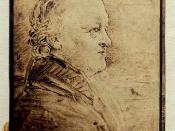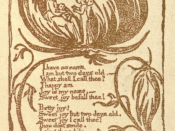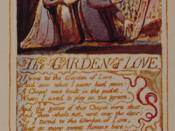William Blake Critical Analysis Paper In 1794 William Blake issued a two- volume collection of poems in a book titled Songs of Innocence and of Experience. This book included hand painted illustrations along with the poems mounted on copper plates. These poems have been called "the most remarkable collection of poems written in English (C. M. Bowra 25) ."� The intent of these works was to show the two contrary states of the human soul. Though this goal differed from that of Blake's prophetic works, there are no doubt some distinct similarities. The characters and situations in Blake's poems represent the mythological characters found in Blake's prophetic works. For example, in the poem The Garden of Love the narrator sees the garden where he used to play now transformed into a chapel. He sees the priests in black gowns who "bind his joys and desires."� In this poem the priests represent Urizen from the prophetic works who binds the other three aspects of the human personality including Orc; physical desires.
In these poems Blake shows the contrast between innocence and experience. He shows innocence as happy state while "experience is a state of disillusionment and of knowledge of life in all its bitterness (Nurmi 59)."� Using the two poems Infant Joy and Infant Sorrow Blake shows how the imaginative state of childhood innocence is destroyed by experience, gained from society, economic situations and life's hardships.
The poem Infant Joy opens with the infant speaking to the narrator. He \ she tells the narrator that he \ she has no name then when asked "what shall I call thee? "� he \ she replies "I happy am."� In these lines Blake tries to capture the innocence of infancy. He uses the infant as symbol of the happiness that accompanies innocence.


